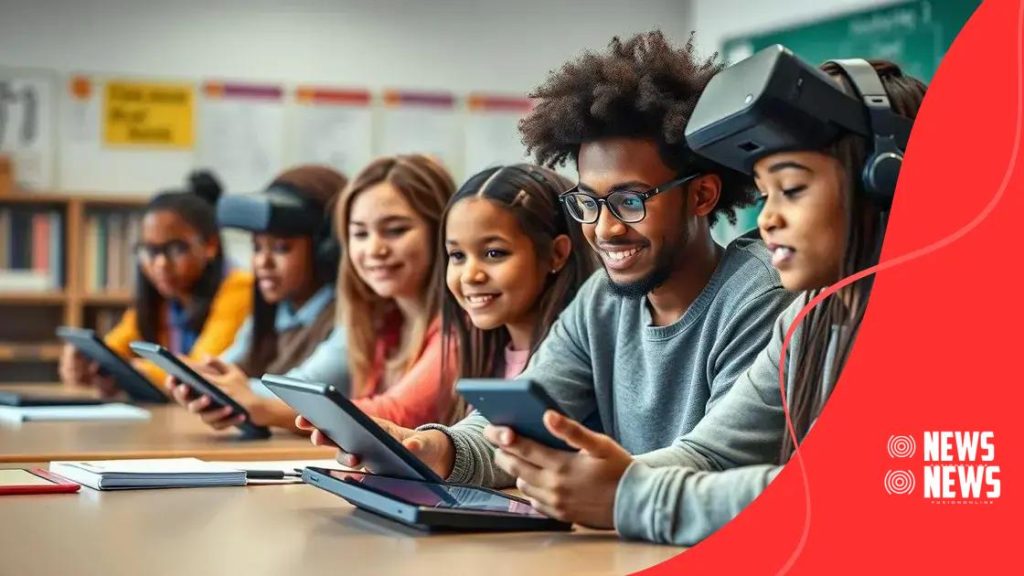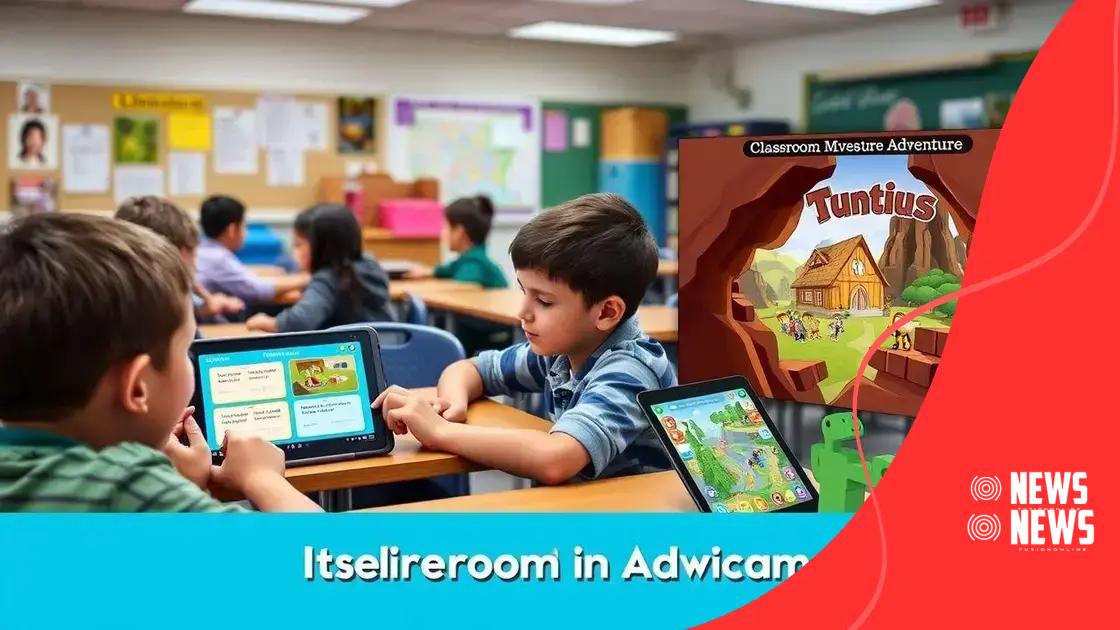Gamification in education: engaging the modern learner

Gamification in education enhances student engagement and motivation by incorporating game-like elements, such as rewards and challenges, into learning experiences to create a more interactive and enjoyable classroom environment.
Gamification in education is revolutionizing how students engage with learning. Imagine turning a dull lecture into an exciting game! This approach captures attention and motivates students to participate actively.
Understanding gamification and its principles
Understanding gamification is key to leveraging its benefits in education. Simply put, gamification involves applying game-like elements in non-game contexts. In classrooms, it transforms the learning experience, making it more engaging for students.
At its core, there are several principles of gamification that enhance learning:
Motivation and Engagement
One of the primary goals of gamification is to boost motivation. By incorporating elements such as rewards, challenges, and feedback, students become more invested in their learning process. They are not just recipients of information; they are active participants.
Another important aspect is the introduction of challenges. These can take many forms, like quizzes or teamwork tasks, encouraging collaboration and critical thinking.
Immediate Feedback
Gamification also offers immediate feedback, essential for effective learning. When students receive quick responses to their actions, they can adjust their strategies promptly. This real-time interaction enhances their understanding.
- Instant results can boost confidence.
- It allows for immediate corrections of misconceptions.
- Encourages a growth mindset by embracing mistakes.
Moreover, progress tracking adds another layer of motivation. Many gamified systems provide visual representations of advancement, such as bars or badges, showing students how far they’ve come. This visual cue fosters a sense of achievement.
Further, by facilitating a sense of community, gamification can enhance peer interaction in the learning environment. When students participate in challenges and compete or collaborate with their peers, they build relationships that can deepen their engagement.
Benefits of gamification in classroom settings
The benefits of gamification in classroom settings are profound. By incorporating game principles, teachers can create a more dynamic and engaging environment. Students often show increased enthusiasm for learning when they encounter challenges that make the process feel like a game.
One significant advantage is that gamification leads to higher levels of student engagement. When lessons are designed like games, learners are more likely to participate actively and stay focused. They enjoy the process of earning rewards, which further motivates them to continue.
Enhanced Retention of Information
Games encourage repetition, making it easier for students to grasp and retain new concepts. By allowing learners to practice skills in a fun way, they can better remember what they learn. In a typical gamified lesson, students might engage in activities like quizzes and interactive challenges that reinforce their knowledge.
- Active participation helps cement learning.
- Fun activities make remembering facts easier.
- The competition can enhance focus and effort.
Additionally, gamification fosters a sense of achievement. As students progress through levels or earn points, they feel a sense of accomplishment. This can be particularly beneficial for struggling students, as small achievements can significantly boost their confidence.
Promotion of Collaboration
Moreover, gamified environments often encourage collaboration among classmates. When learners work together to solve problems or compete in teams, they build important social skills. Collaboration also makes learning more enjoyable, fostering a supportive community in the classroom.
By promoting teamwork, games can help students develop vital skills like communication, negotiation, and empathy. These skills are crucial not only for success in school but also later in life.
Examples of successful gamification in education

There are numerous examples of successful gamification in education that illustrate its effectiveness in engaging students. Many schools and educators have embraced this approach, leading to remarkable outcomes.
One popular example is the use of points and badges systems in classrooms. Teachers assign points for completing tasks or participating in discussions. As students accumulate points, they earn badges that signify their achievements. This method boosts their motivation and encourages friendly competition.
Quizizz
Another great example is Quizizz, an online platform where educators create quizzes that students can answer in a game-like format. Students compete against each other while answering questions, making learning fun and interactive. The immediate feedback helps them learn from their mistakes while enjoying the game.
- Interactive gameplay keeps students engaged.
- Real-time feedback enhances understanding.
- Encourages participation and teamwork.
Furthermore, platforms like Kahoot! offer similar benefits. Teachers can create quizzes that students answer using their devices, promoting excitement and motivation. The competitive atmosphere and lively visuals make learning memorable.
Classcraft
Classcraft takes gamification a step further by turning the classroom into an adventure game. Students create avatars and earn rewards for positive behavior. This system transforms classroom management into a fun experience, improving both engagement and behavior.
These examples show how gamification can enhance learning. When students enjoy the process, they are more likely to absorb information and perform better academically.
Implementing gamification strategies
Implementing gamification strategies in the classroom can transform the learning experience for students. These strategies involve integrating game-like elements into everyday lessons, enhancing engagement, and making learning more enjoyable.
One of the first steps is to define clear objectives. Educators should identify what they want to achieve through gamification. For example, they might aim to increase participation, enhance retention, or foster collaboration among students.
Designing Meaningful Challenges
Creating challenges that are both meaningful and relevant is crucial. Tasks should be tailored to the curriculum and should engage students’ interests and skills. This ensures that the gamified activities are not only fun but also educationally valuable.
- Challenges should relate to real-world scenarios.
- Incorporate levels of difficulty to suit different learners.
- Offer incentives like points or rewards for completing tasks.
Another strategy is to use technology effectively. Platforms like Kahoot!, Quizizz, or Classcraft provide tools that make it easy to implement gamification. Through these platforms, teachers can create quizzes, share interactive lessons, and track student progress in real time.
Encouraging Collaboration
Encouraging collaboration among students is another essential aspect of implementation. Group activities can foster teamwork and communication skills, allowing students to learn from one another. Gamification can turn group tasks into competitions or cooperative challenges that require collaboration to succeed.
Lastly, it’s important to collect feedback from students to improve the gamification process continually. Understanding what students enjoy and what challenges they face can help educators refine their strategies. Regular adjustments can keep the experience fresh and engaging for all learners.
Measuring the impact of gamification on student engagement
Measuring the impact of gamification on student engagement is essential for understanding its effectiveness in the classroom. By evaluating how gamified elements influence student motivation and involvement, educators can improve their teaching methods.
One effective way to gauge engagement is through surveys. Teachers can create questionnaires that students fill out before and after implementing gamification strategies. These surveys can ask about students’ interests, participation levels, and feelings towards learning. Analyzing the responses helps identify areas needing improvement.
Tracking Participation Metrics
Another important aspect is tracking participation metrics. Teachers can monitor how often students participate in gamified activities compared to traditional lessons. Keeping records of classroom participation, assignment completion rates, and attendance can provide valuable insights.
- Analyze data to see increases in class participation.
- Compare completion rates of assignments before and after gamification.
- Use classroom observation to note changes in student behavior.
Additionally, utilizing educational technology platforms can help measure engagement through real-time analytics. Platforms like Kahoot! and Quizizz provide data on how students perform in quizzes and interactive games. This immediate feedback can highlight trends in engagement levels.
Feedback from Students
Collecting feedback from students directly can also yield meaningful insights. Students often have valuable opinions on what motivates them. By asking questions about their experiences with gamification, teachers can adjust their approaches accordingly. This feedback loop helps create a more engaging learning environment.
Ultimately, combining various methods of assessment leads to a comprehensive understanding of gamification’s impact on student engagement. By analyzing surveys, participation metrics, technology analytics, and student feedback, educators can refine their strategies to enhance learning outcomes.
In summary, gamification in education offers significant benefits by enhancing student engagement and motivation. By implementing game-like elements in the classroom, educators can create a more interactive and enjoyable learning environment. The strategies discussed—such as utilizing technology, designing meaningful challenges, and tracking student progress—are essential for measuring the real impact of gamification. As we continue to explore these techniques, it’s clear that they lead to better outcomes for students, making education a more exciting journey.
FAQ – Frequently Asked Questions about Gamification in Education
What is gamification in education?
Gamification in education involves using game-like elements, such as points and rewards, to enhance student engagement and motivation.
How can gamification improve student learning?
Gamification can make learning more interactive and enjoyable, leading to increased participation and a better understanding of the material.
What tools can teachers use for gamification?
Teachers can use platforms like Kahoot!, Quizizz, and Classcraft to implement gamification strategies effectively.
How can I measure the impact of gamification in my classroom?
You can measure gamification’s impact by tracking participation metrics, collecting student feedback, and analyzing survey results.





